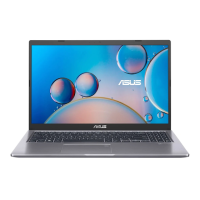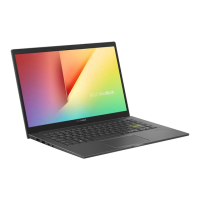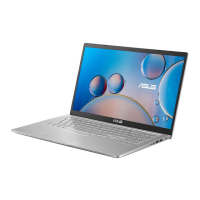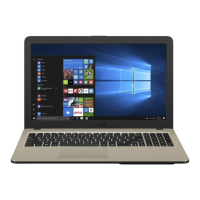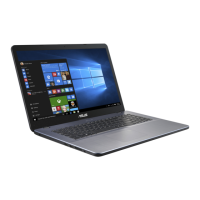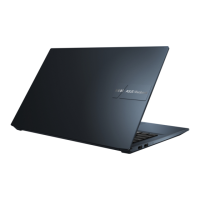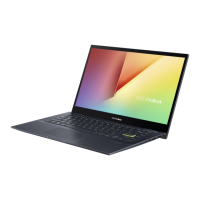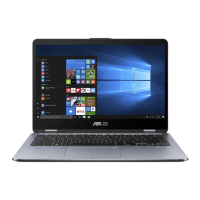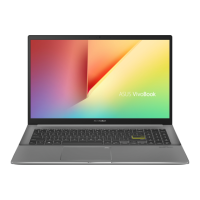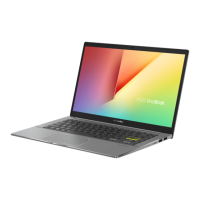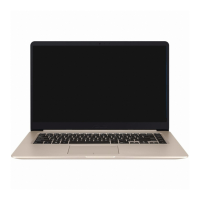Do you have a question about the Asus Vivobook 16X M1603 and is the answer not in the manual?
Explains document conventions for icons, typography, and important notes.
Details the meaning of icons used and formatting for text.
Provides safety guidelines for using the notebook PC in various environments.
Instructions on cleaning, maintenance, and proper disposal of the notebook PC.
Critical safety information regarding notebook battery protection and handling.
Detailed diagrams and descriptions of notebook PC external components and ports.
Identifies and describes components visible from the top, including screen, keyboard, and ports.
Details components located on the bottom of the notebook, such as vents and speakers.
Lists and explains ports and connectors found on the right side of the notebook PC.
Describes ports and status indicators located on the left side of the notebook PC.
Initial steps for setting up and powering on your new notebook PC.
Instructions for connecting the power adapter and charging the notebook battery.
Guide on how to open the display panel and press the power button.
Explains various touch gestures for navigation and interaction with the touchpad.
How to move the cursor using sliding motions on the touchpad.
Covers single, double, three, and four-finger touch gestures for various functions.
Details special keys, shortcuts, and functions available on the notebook keyboard.
Describes function keys (F1-F12) that trigger specific commands or features.
Explains the use of Fn keys and Windows logo keys for system operations.
Information on using the integrated numeric keypad for input or navigation.
Guide for configuring the operating system during the first boot-up.
Step-by-step process for initial system configuration and personalization.
Navigating the Windows Start menu and managing installed applications.
How to launch programs, access settings, and manage accounts via the Start menu.
Instructions on pinning, unpinning, and moving apps within the Windows interface.
Using Task View to switch between open apps and virtual desktops.
How to launch and customize widgets for quick information access.
Steps to manage interests and change content displayed in widgets.
Utilizing Snap and Snap Hotspots for arranging apps side-by-side.
Instructions on how to snap applications to the screen edges.
Managing notifications and quick actions through the Windows Action Center.
Accessing and using the Quick Actions section within the Action Center.
Viewing and managing system and app notifications.
Adjusting display settings for color accuracy and eye comfort using MyASUS.
Lists useful keyboard shortcuts for launching applications and navigating Windows.
Guides for connecting to networks and managing notebook power states.
Steps to connect the notebook PC to Wi-Fi and Bluetooth networks.
Instructions for pairing the notebook PC with other Bluetooth-enabled devices.
How to enable or disable Airplane mode for wireless communication.
Procedures for shutting down, sleeping, or hibernating the notebook PC.
Methods for performing a normal shutdown or force shutdown of the PC.
Instructions on how to put the notebook PC into sleep mode.
Understanding the POST process and accessing BIOS settings for system configuration.
Explanation of the diagnostic tests performed during system startup.
Steps to enter the BIOS setup utility during the POST sequence.
Methods for restoring or refreshing the notebook PC's system and settings.
Details on 'Keep my files', 'Remove everything', and 'Advanced startup' recovery options.
Recommendations for maximizing notebook performance, security, and battery life.
Answers to frequently asked questions for hardware and software issues.
Solutions to common hardware problems like display issues and battery life.
Troubleshooting steps for software-related issues like boot problems and screen messages.
Statements regarding FCC, ISED, and other regulatory compliance for the device.
Information on FCC rules, interference, and RF exposure compliance.
Compliance statement for Innovation, Science and Economic Development Canada.
Important safety, environmental, and battery handling notices.
Safety requirements and precautions related to UL certifications for electrical products.
Warnings and guidelines for handling lithium-ion batteries to prevent explosion or damage.
Information on compliance with environmental regulations like RoHS and REACH.
Details on the product's qualification for ENERGY STAR and EPEAT environmental programs.
Miscellaneous notices including regional compliance, licenses, and declarations.
Specific compliance notices for regions like Singapore.
Information regarding the license for BIOS text fonts.
Official declarations of the product's compliance with EU and UKCA regulations.
